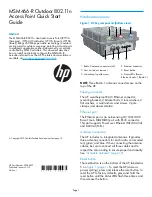
Safety and Regulatory Information
Protection equipment needed
In addition to the items supplied with the AP, protection
equipment is required according to your electrical
code. Consult the respective Antenna Guide (available
online, search by antenna part number), including the
Lightning Arrester section for important safety
information and instructions. Although the AP includes
a built-in Ethernet surge suppressor, HP strongly
recommends that you add an Ethernet surge suppressor
where the Ethernet cable enters the building.
Important information to read before installing
WARNING
: Professional installation is required.
For outdoor or indoor installation. Prior to installing
or using the AP, consult with a professional installer
trained in RF installation and knowledgeable in local
regulations including building and wiring codes,
safety, channel, power, outdoor/indoor restrictions,
and license requirements for the intended country. It
is the responsibility of the end user to ensure that
installation and use complies with local safety and
radio regulations.
Surge protection and grounding
: When connecting
antennas installed outdoors to the AP, make sure that
proper lightning surge protection and grounding
precautions are taken according to local electrical
code. Failure to do so can result in personal injury,
fire, equipment damage, or a voided warranty. The
HP hardware warranty provides no protection against
damage caused by static discharge or a lightning
strike. Lightening Arresters (J8996A) are available
from HP. One arrester is required for each antenna
connector (total of 6).
Cabling
: You must use Cat 5e (or better) cables, and
where applicable for your region, surge protection.
Country of use
: In some regions, you are prompted to
select the country of use during setup. After the country
has been set, the AP automatically limits the available
wireless channels, ensuring compliant operation in the
selected country. Entering the incorrect country can
result in illegal operation and can cause harmful
interference to other systems.
Safety
: Consider the following safety information
during installation:
•
If your network covers an area served by more
than one power distribution system, make sure all
safety grounds are securely interconnected.
•
Network cables are subject to hazardous transient
voltages (caused by lightning or disturbances in
the electrical power grid).
•
Handle exposed metal components of the network
with caution.
•
The AP is powered-on when connected to a PoE
power source.
Powering the AP
IMPORTANT
: Typically, the AP requires 802.3af
power; however, for operation below -20°C (-4°F),
802.3at power is required to activate the integrated
heater. The AP automatically detects the type of PoE
source and turns on the heater only when 802.3at
power is detected and heating is required. When first
powered on at temperatures below 0°C (32°F) (with
either power source), it can take a few minutes for the
AP to heat up internally before it becomes fully
operational.
The AP can be powered by:
•
A 10/100/1000 PoE-enabled (802.3af or
802.3at) switch. Various PoE-enabled switches
are available from HP.
•
HP 1-Port 802.3af Gig PoE Power Injector
(J9407B).
•
HP 1-Port 802.3at Gig PoE Power Injector
(JD054A).
CAUTION
: If the AP will be powered by a user-supplied
PoE power injector, use only a gigabit-compatible
power injector. PoE injectors designed for 10/100
networks only are not compatible with the AP.
Installation
Identify a suitable installation location. The AP is IP67
and NEMA 4X rated, providing protection against
water intrusion and salt fog damage. Local electrical
and building codes and regional regulations dictate
many aspects of your installation. HP recommends that
you test transmission and reception at the proposed
location before installing.
You must provide an effective earth ground for the AP.
It is rarely sufficient to use a metal pole for equipment
Page 2




























